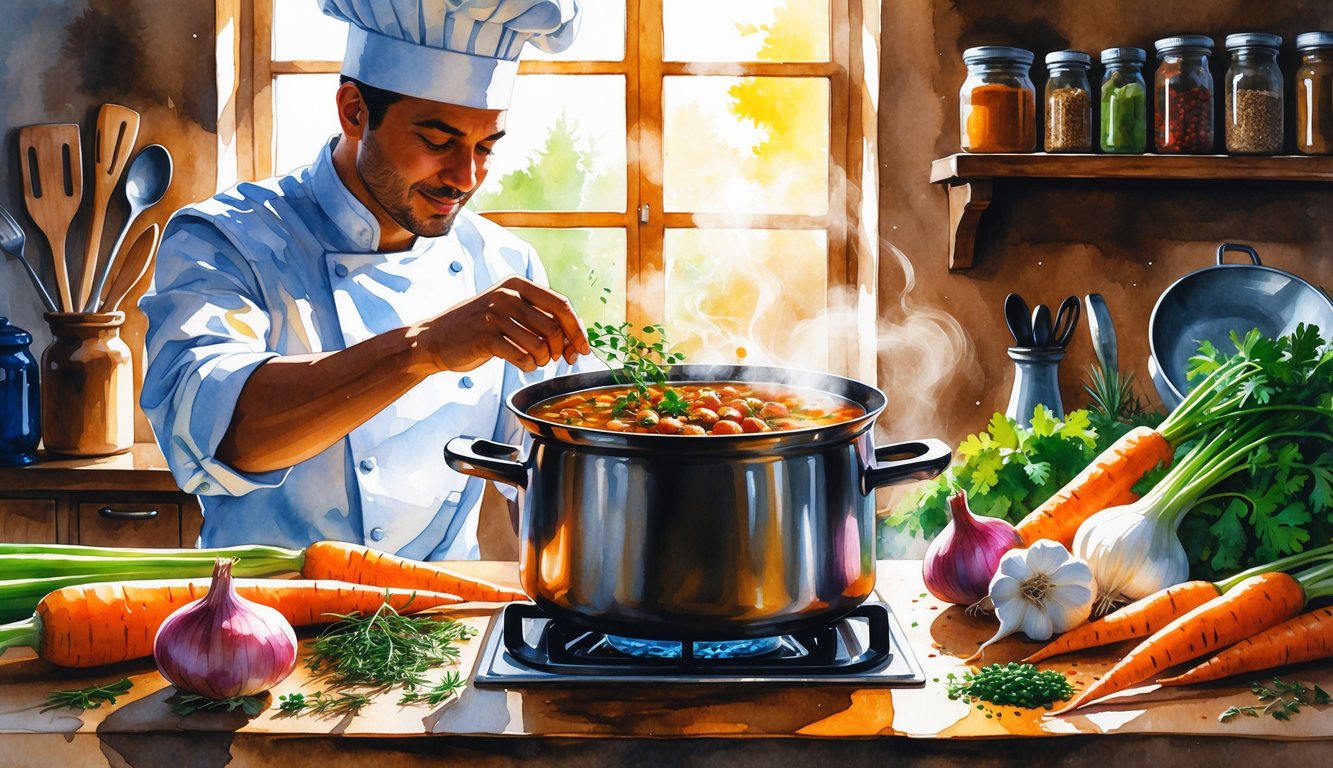
Finishing Touches and Serving Suggestions
After all the fussing over pots and fancy beef, somehow, it’s always the last-minute touches people talk about. Not the hours of simmering, not the perfect sear—just whatever you tossed on top. I don’t get it, but it’s true.
Adding Fresh Herbs for a Burst of Flavor
Every time I forget herbs, I regret it. Parsley, chives, whatever’s not dead in the fridge. You don’t need a garden, just a handful. Toss them on right before serving. It just wakes everything up. If you add them too early, you stew the flavor away—pro tip.
Don’t overdo it. One tablespoon, scattered, is enough. Some chefs go for microgreens, but regular herbs are fine. My cousin once dumped oregano in at the start. Whole thing tasted like pizza. Disaster.
Pairing With Crusty Bread or Sides
Tried skipping bread once. Never again. People care more about the bread than the stew. Baguette, rye, even supermarket rolls—just make sure it’s crusty. Flimsy bread just floats and gets gross. My Kitchen Gallery says crunchy bread is basically required.
Green salad? I’m torn. Half the table loves it, half says skip it. Bitter greens with lemon vinaigrette do cut the richness, though. Just, please, no croutons—double crunch is weird. Last potluck, someone brought naan and everyone ignored my stew for the bread. Bread always wins.
Frequently Asked Questions
I keep circling the same questions—why does restaurant stew taste so much better? Mine’s always just okay, even after hours. Secret tricks, timing, weird ingredients—chefs always have something up their sleeve.
What can I add to my beef stew for a deeper flavor?
Sear harder. Throw beef cubes into a screaming hot pan, don’t crowd them. That Maillard reaction is where the magic is, not the slow simmer.
Stock matters. If you can, make your own. I once dumped in fish sauce and everyone looked at me like I’d cast a spell. No magic—just umami bombs. Anchovy paste, tomato paste, Worcestershire, bay, rosemary, whatever you have, all in.
How can top chefs transform a simple chicken stew into a gourmet experience?
Fresh tarragon at the end. But don’t forget the potatoes—mine turned to glue after I cranked the heat, thinking it’d thicken faster. Never again. Chefs layer flavor: aromatics in olive oil, then wine, then lemon zest sneaks in under the cream and salt.
Some French chef told me (after midnight, over spilled wine) never add dairy until the very end—apparently, that keeps it from splitting. I thought it was inevitable. Techniques matter, but so does not overdoing it. Too much of anything and you’ve ruined it.
Is there a secret ingredient that elevates beef stew to the next level?
Okay, so, vinegar. I know, right? Sounds weirdly basic and not at all like something a “serious” chef would admit to, but honestly? A glug of balsamic or, whatever, a shot of sherry dumped in at the end, and suddenly the whole thing doesn’t taste like leftovers from a hospital cafeteria. It’s like, why does this work? No idea. I read somewhere that chefs like to toss in some secret ingredient at the last second, and now I’m suspicious of every “family recipe” that claims to be the real deal. Here’s someone else who thinks so, too.
Oh, and dark chocolate. No, I’m not joking. I used to think that was a meme or something, but I melted a square in once (maybe twice, whatever), and it was actually… kind of amazing? Then there’s this one guy I used to work with who’d throw in a single star anise—felt like a gimmick, but damn, it was good. Now I’m just annoyed that I liked it. Why does one tiny thing make me rethink every stew my grandma ever made?
What should I avoid putting in my stew to maintain its authentic taste?
Frozen diced carrots. I mean, unless you like eating baby food that’s been reheated three times. They go all mushy and weirdly sweet, and suddenly your stew tastes like some kind of mystery dessert. Also, I’ve seen people throw in “Italian seasoning” like it’s confetti. Oregano in beef stew? Why, just why? I swear, some people must have broken tastebuds. Or maybe their Nonna never yelled at them.
And flour. I get it, you want it thick, but dumping flour in at the start? It just makes everything gluey. Cornstarch is sneakier, but half the time it leaves that shiny, take-out sauce vibe. Not what I came here for. Oh, and don’t even get me started on cheap wine. If you wouldn’t drink it, don’t put it in your stew. I’d rather skip it than ruin the whole pot with something that tastes like vinegar pretending to be wine.
How do professional chefs enhance the flavor of a bland stew?
Salt’s obvious. But acid—yeah, that’s the real fix. Lemon zest, a splash of vinegar, or just something pickled you forgot about in the fridge. I’ve definitely panicked and dumped in a handful of herbs at the end because, let’s be honest, sometimes you just need to shout at a stew to wake it up. Apparently, herbs at different times actually matter. Who knew?
Oh, and those brown bits stuck on the bottom? Scrape them up before you pour in anything else. Deglaze with brandy, wine, or broth if you’re feeling fancy, but water’s just sad. And I always swirl in a bit of butter at the end—not for the look, just because it tastes way better. Someone once told me to grate raw garlic over the top right before serving. I thought it’d be weird, but honestly? It’s kind of genius. Or maybe I was just hungry.
What quantity of tomato paste is recommended for the perfect beef stew?
Honestly? I start with a tablespoon per pound of beef, but then I’ve seen people just dump in a ton more, especially if the tomatoes are meh. Sometimes they double it. Does it ruin everything? Weirdly, no. Usually tastes fine. Go past two tablespoons, though, and suddenly it’s like, “Why does my stew taste like a tomato explosion?” Not in a good way.
Oh, and you have to fry the paste first. Seriously, don’t just plop it in raw. That stuff just sits there, all sour and weird, like it’s mad at you. Cook it till it turns this deep reddish-brown and smells sort of toasty—then throw in your stock. Skip that step and, I swear, the stew always feels hollow. Is it just me? Maybe. But I’m not risking it.



